Improved Prediction Model and Utilization of Pump as Turbine for Excess Power Saving from Large Pumping System in Saudi Arabia
Abstract
1. Introduction
- It was never introduced to the refined product industry as presented here.
- The models proposed in the literature are extensive but their accuracy and percentage deviation from the experimental data are higher in different modes and applications. It is the need of the day to develop a new model which predicts the PAT performance with better accuracy.
- None of the models proposed in the literature are able to predict the power output of the PAT. A new model is needed which is able to predict the power output correctly while predicting the other performance parameters closely.
2. Methodology
2.1. The Facility Layout
2.2. Pumping Cost
2.3. PRVs Theoretical Available Throttling Power
2.4. System Layout
- Maximum power recovery compared to the overall theoretical available power across the system-installed PRVs.
- Full compliance with the design operating parameters without compromising the overall system performance.
- Minimal capital payback period for the selected PATs installation layout.
2.5. PAT Selection
2.5.1. Single Mode
2.5.2. Semiparallel Mode
2.5.3. Parallel Mode
2.6. Proposed Model
- Pump and PAT efficiencies at the BEP are almost equal, provided that the pump is running in reverse mode at the required higher flow rate and head.
- Pump consumed power and PAT generated power are almost the same at the BEP.
- Point #1: zero power where the efficiency is equal to zero (at pump MCSF).
- Point #2: related power at the identified turbine MCSF.
2.7. Economic Analysis
3. Results and Discussion
3.1. Power Consumption and Pumping Cost
3.2. PRVs Theoretical Available Throttling Power
3.3. Percentage of Power Recovered using PAT
3.4. Comparison of Proposed Model with Experimental Data and Previous Models
- Turbine flow rate at BEP.
- Turbine head at BEP.
- Turbine head drop at the design flow rate.
- Turbine power at the design flow rate.
| Model | Flow Ratio (q) | Dev. (%) | Head Ratio (h) | Dev. (%) | Head Drop * (m) | Dev. (%) | Power * (kW) | Dev. (%) | Power + (kW) | Dev. (%) |
|---|---|---|---|---|---|---|---|---|---|---|
| Nautiyal et al. [18] | 1.38 | 15.56 | 1.57 | 17.14 | 477.1 | −4.58 | 262.5 | −45.91 | 318.8 | −45.80 |
| Stepanoff [19] | 1.12 | −6.35 | 1.26 | −6.18 | 528.4 | 5.68 | 251.7 | −48.14 | 305.6 | −48.04 |
| Childs [20] | 1.26 | 4.90 | 1.26 | −6.18 | 440.6 | −11.88 | 192.1 | −60.42 | 233.2 | −60.34 |
| Sharma [21] | 1.20 | 0.24 | 1.31 | −1.82 | 494.9 | −1.02 | 240.1 | −50.52 | 291.6 | −50.42 |
| Alatorre and Thomas [22] | 1.51 | 26.04 | 1.52 | 13.56 | 411.6 | −17.68 | 193.3 | −60.17 | 234.7 | −60.09 |
| Yang et al. [13] | 1.36 | 13.65 | 1.54 | 15.16 | 480.2 | −3.96 | 262.5 | −45.91 | 318.7 | −45.80 |
| Derakhshan and Nourbakhsh [6] | 1.51 | 26.02 | 1.93 | 44.18 | 522.7 | 4.54 | 351.2 | −27.63 | 426.5 | −27.48 |
| Proposed Model | 1.24 | 3.83 | 1.27 | −5.20 | 434.9 | −3.03 | 448.1 | −7.67 | 544.1 | −7.48 |
| Manufacturer Data | 1.20 | 0 | 1.34 | 0 | 500 | 0 | 485.3 | 0 | 588.1 | 0 |
| Model | Flow Ratio (q) | Dev. (%) | Head Ratio (h) | Dev. (%) | Head Drop * (m) | Dev. (%) | Power * (kW) | Dev. (%) | Power + (kW) | Dev. (%) |
|---|---|---|---|---|---|---|---|---|---|---|
| Nautiyal et al. [18] | 1.65 | 38.59 | 1.93 | 52.33 | 518.8 | 3.76 | 320.2 | −50.68 | 388.9 | −50.62 |
| Stepanoff [19] | 1.10 | −7.67 | 1.21 | −5.00 | 543.0 | 8.60 | 297.9 | −54.12 | 361.8 | −54.06 |
| Childs [20] | 1.21 | 1.35 | 1.21 | −5.00 | 472.2 | −5.56 | 236.5 | −63.58 | 287.1 | −63.54 |
| Sharma [21] | 1.16 | −2.36 | 1.25 | −1.40 | 517.6 | 3.52 | 282.0 | −56.56 | 346.1 | −56.05 |
| Alatorre and Thomas [22] | 1.32 | 10.98 | 1.39 | 9.54 | 480.6 | −3.88 | 266.5 | −58.95 | 323.7 | −58.90 |
| Yang et al. [13] | 1.33 | 11.84 | 1.47 | 16.13 | 504.5 | 0.90 | 302.2 | −53.45 | 367.0 | −53.40 |
| Derakhshan and Nourbakhsh [6] | 1.51 | 26.94 | 1.93 | 51.92 | 567.0 | 13.4 | 415.5 | −36.00 | 504.6 | −35.93 |
| Proposed Model | 1.18 | −1.14 | 1.24 | −1.22 | 501.6 | 0.32 | 649.0 | −0.05 | 788.1 | 0.07 |
| Manufacturer Data | 1.19 | 0 | 1.27 | 0 | 500.0 | 0 | 649.3 | 0 | 787.5 | 0 |
| Model | Flow Ratio (q) | Dev. (%) | Head Ratio (h) | Dev. (%) | Head Drop * (m) | Dev. (%) | Power * (kW) | Dev. (%) | Power + (kW) | Dev. (%) |
|---|---|---|---|---|---|---|---|---|---|---|
| Nautiyal et al. [18] | 1.47 | 23.95 | 1.69 | 24.20 | 491.3 | −1.74 | 119.4 | −67.67 | 145.0 | −67.56 |
| Stepanoff [19] | 1.11 | −6.30 | 1.24 | −8.94 | 494.0 | −1.20 | 123.7 | −66.49 | 150.3 | −66.38 |
| Childs [20] | 1.24 | 4.38 | 1.24 | −8.94 | 431.1 | −13.78 | 92.2 | −75.02 | 112.0 | −74.94 |
| Sharma [21] | 1.19 | −0.03 | 1.30 | −4.92 | 474.3 | −5.14 | 115.8 | −68.63 | 140.6 | −68.53 |
| Alatorre and Thomas [22] | 1.46 | 22.55 | 1.48 | 8.88 | 435.2 | −12.96 | 89.1 | −75.86 | 108.2 | −75.79 |
| Yang et al. [13] | 1.35 | 13.66 | 1.52 | 11.67 | 480.7 | −3.86 | 119.8 | −67.54 | 145.5 | −67.44 |
| Derakhshan and Nourbakhsh [6] | 1.40 | 17.99 | 2.01 | 47.67 | 612.0 | 22.40 | 215.0 | −41.77 | 261.1 | −41.58 |
| Proposed Model | 1.21 | 1.35 | 1.28 | −6.22 | 508.1 | 1.63 | 356.4 | −3.47 | 432.8 | −3.16 |
| Manufacturer Data | 1.19 | 0 | 1.36 | 0 | 500.0 | 0 | 369.2 | 0 | 446.9 | 0 |
3.5. Validation of Proposed Model for Other Pumps
3.6. Economic Analysis
- One PAT in place of either shipper-pump B or C discharge PRVs for the single-shipper single-booster operating mode.
- One PAT in place of shipper-pump A discharge PRV for the semiparallel operating mode.
- One PAT in place of shipper-pump B and C discharge PRVs for the parallel operating mode.
4. Conclusions and Future Work
Author Contributions
Funding
Institutional Review Board Statement
Informed Consent Statement
Data Availability Statement
Conflicts of Interest
Abbreviations
| ACS | Annual cost saving |
| BEP | Best efficiency point |
| CCR | Electricity commercial cost rate |
| CFD | Computational fluid dynamics |
| CPP | Capital payback time |
| CW | Civil work |
| EGE | Energy generation equipment |
| HPRT | Hydraulic power recovery turbine |
| MOC | Method of characteristics |
| MC | Maintenance cost |
| MCSF | Manufacture-provided minimum continuous stable flow |
| NPSH | Net-positive suction head |
| PAT | Pump as turbine |
| PRVs | Pressure reducing valves |
| SG | Specific gravity |
| VFDs | Variable frequency drivers |
| WDN | Water distribution networks |
| WDS | Water distribution system |
| Symbols | |
| D | Number of running days per year |
| g | Gravitational Acceleration; m/s2 |
| H | Head; m |
| Iavg | Equipment average electrical current; A |
| PF | Power factor |
| PAT power at BEP; W | |
| Pth | Theoretical available power; W |
| Average power consumption; W | |
| Turbine power at BEP; W | |
| PTotal | Total power consumption; W |
| Q | Flow rate; m3/s |
| T | Equipment running time; h |
| V | Voltage; V |
| ρ | Density of fluid; kg/m3 |
| λ | Head value at the maximum pump flow rate; m |
| ηp | Pump efficiency |
| ηt | Turbine efficiency |
References
- De Marchis, M.; Fontanazza, C.M.; Freni, G.; Messineo, A.; Milici, B.; Napoli, E.; Notaro, V.; Puleo, V.; Scopa, A. Energy Recovery in Water Distribution Networks. Implementation of Pumps as Turbine in a Dynamic Numerical Model. Procedia Eng. 2014, 70, 439–448. [Google Scholar] [CrossRef]
- Singh, P. The choice between turbine expanders and variable speed pumps as replacement for throttling devices in non-thermal process applications. Energy 2017, 123, 198–217. [Google Scholar] [CrossRef]
- Darvini, G.; Soldini, L. Pressure control for WDS management. A case study. Procedia Eng. 2015, 119, 984–993. [Google Scholar] [CrossRef]
- Thoma, D.; Kittredge, C.P. Centrifugal pumps operated under abnormal conditions. J. Power Sources 1931, 73, 881–884. [Google Scholar]
- Giosio, D.; Henderson, A.; Walker, J.; Brandner, P.; Sargison, J.; Gautam, P. Design and performance evaluation of a pump-as-turbine micro-hydro test facility with incorporated inlet flow control. Renew. Energy 2015, 78, 1–6. [Google Scholar] [CrossRef]
- Derakhshan, S.; Nourbakhsh, A. Experimental study of characteristic curves of centrifugal pumps working as turbines in different specific speeds. Exp. Therm. Fluid Sci. 2008, 32, 800–807. [Google Scholar] [CrossRef]
- Lima, G.M.; Luvizotto, E.; Brentan, B.M. Selection and location of Pumps as Turbines substituting pressure reducing valves. Renew. Energy 2017, 109, 392–405. [Google Scholar] [CrossRef]
- Pugliese, F.; De Paola, F.; Fontana, N.; Giugni, M.; Marini, G. Experimental characterization of two Pumps as Turbines for hydropower generation. Renew. Energy 2016, 99, 180–187. [Google Scholar] [CrossRef]
- Carravetta, A.; Fecarotta, O.; Sinagra, M.; Tucciarelli, T. Cost-Benefit Analysis for Hydropower Production in Water Distribution Networks by a Pump as Turbine. J. Water Resour. Plan. Manag. 2014, 140, 04014002. [Google Scholar] [CrossRef]
- Binama, M.; Su, W.-T.; Li, X.-B.; Li, F.-C.; Wei, X.-Z.; An, S. Investigation on pump as turbine (PAT) technical aspects for micro hydropower schemes: A state-of-the-art review. Renew. Sustain. Energy Rev. 2017, 79, 148–179. [Google Scholar] [CrossRef]
- Danish, S.N.; Qureshi, S.R.; Imran, M.M.; Khan, S.U.-D.; Sarfraz, M.M.; El-Leathy, A.; Al-Ansary, H.; Wei, M. Effect of tip clearance and rotor–stator axial gap on the efficiency of a multistage compressor. Appl. Therm. Eng. 2016, 99, 988–995. [Google Scholar] [CrossRef]
- Sharma, R.L. Pumps as turbines (PAT) for small hydro. Indian J. Power River Vall. Dev. 1998, 49, 44–48. [Google Scholar]
- Yang, S.-S.; Derakhshan, S.; Kong, F.-Y. Theoretical, numerical and experimental prediction of pump as turbine performance. Renew. Energy 2012, 48, 507–513. [Google Scholar] [CrossRef]
- Stefanizzi, M.; Torresi, M.; Fortunato, B.; Camporeale, S. Experimental investigation and performance prediction modeling of a single stage centrifugal pump operating as turbine. Energy Procedia 2017, 126, 589–596. [Google Scholar] [CrossRef]
- Du, J.; Yang, H.; Shen, Z.; Chen, J. Micro hydro power generation from water supply system in high rise buildings using pump as turbines. Energy 2017, 137, 431–440. [Google Scholar] [CrossRef]
- Buono, D.; Frosina, E.; Mazzone, A.; Cesaro, U.; Senatore, A. Study of a Pump as Turbine for a Hydraulic Urban Network Using a Tridimensional CFD Modeling Methodology. Energy Procedia 2015, 82, 201–208. [Google Scholar] [CrossRef]
- Frosina, E.; Buono, D.; Senatore, A. A Performance Prediction Method for Pumps as Turbines (PAT) Using a Computational Fluid Dynamics (CFD) Modeling Approach. Energies 2017, 10, 103. [Google Scholar] [CrossRef]
- Nautiyal, H.; Varun, V.; Kumar, A.; Yadav, S. Experimental investigation of centrifugal pump working as turbine for small hydropower systems. Energy Sci. Technol. 2011, 1, 79–86. [Google Scholar]
- Stepanoff, A.J. Centrifugal and Axial Flow Pumps: Theory, Design, and Application, 2nd ed.; Krieger Publishing Company: Malabar, FL, USA, 1957. [Google Scholar]
- Childs, S. Convert pumps to turbine and recover HP. Hydrocarb. Process. Pet. Refin. 1962, 41, 173–174. [Google Scholar]
- Sharma, K. Small Hydroelectric Project-use of Centrifugal Pumps as Turbines: Technical Report; Kirloskar Electric Co.: Bangalore, India, 1985. [Google Scholar]
- Alatorre-Frenk, C.; Thomas, T.H. The pumps as turbines approach to small hydropower. In Proceedings of the World Congress on Renewable Energy, Reading, UK, 23–28 September 1990; Volume 5, pp. 2914–2918. [Google Scholar]
- Williams, A. The turbine performance of centrifugal pumps: A Comparison of prediction methods. Proc. Inst. Mech. Eng. Part A J. Power Energy 1994, 208, 59–66. [Google Scholar] [CrossRef]
- Lydon, T.; Coughlan, P.; Mcnabola, A. Pressure management and energy recovery in water distribution networks: Development of design and selection methodologies using three pump-as-turbine case studies. Renew. Energy 2017, 114, 1038–1050. [Google Scholar] [CrossRef]
- Barbarelli, S.; Amelio, M.; Florio, G.; Scornaienchi, N. Procedure Selecting Pumps Running as Turbines in Micro Hydro Plants. Energy Procedia 2017, 126, 549–556. [Google Scholar] [CrossRef]
- Motwani, K.; Jain, S.; Patel, R. Cost Analysis of Pump as Turbine for Pico Hydropower Plants–A Case Study. Procedia Eng. 2013, 51, 721–726. [Google Scholar] [CrossRef]
- Patelis, M.; Kanakoudis, V.; Gonelas, K. Pressure Management and Energy Recovery Capabilities Using PATs. Procedia Eng. 2016, 162, 503–510. [Google Scholar] [CrossRef]
- Lima, G.M.; Junior, E.L.; Brentan, B.M. Selection of Pumps as Turbines Substituting Pressure Reducing Valves. Procedia Eng. 2017, 186, 676–683. [Google Scholar] [CrossRef]
- Torley, A.R.D.; Chaudhry, M.H. Pump characteristics for transient flow analysis. In Proceedings of the 7th International Conference on Pressure Surges and Fluid Transients in Pipelines and Open Channels, Harrogate, UK, 16–18 April 1994; pp. 461–476. [Google Scholar]
- Derakhshan, S.; Nourbakhsh, A. Theoretical, numerical and experimental investigation of centrifugal pumps in reverse operation. Exp. Therm. Fluid Sci. 2008, 32, 1620–1627. [Google Scholar] [CrossRef]
- Flowserve Corporation | Home. Available online: https://www.flowserve.com/en (accessed on 21 October 2022).
- Chapman, S.J. Electric Machinery Fundamentals; McGraw-Hill: New York, NY, USA, 1998. [Google Scholar]
- Baker Hughes. A GE Company | BHGE | Full stream Oil & Gas. Available online: https://www.bakerhughes.com/ (accessed on 29 December 2022).
- Carravetta, A.; Houreh, S.D.; Ramos, H.M. Pumps as Turbines: Fundamentals and Applications; Springer: Cham, Switzerland, 2018. [Google Scholar]
- Fontana, N.; Giugni, M.; Portolano, D. Losses Reduction and Energy Production in Water-Distribution Networks. J. Water Resour. Plan. Manag. 2012, 138, 237–244. [Google Scholar] [CrossRef]

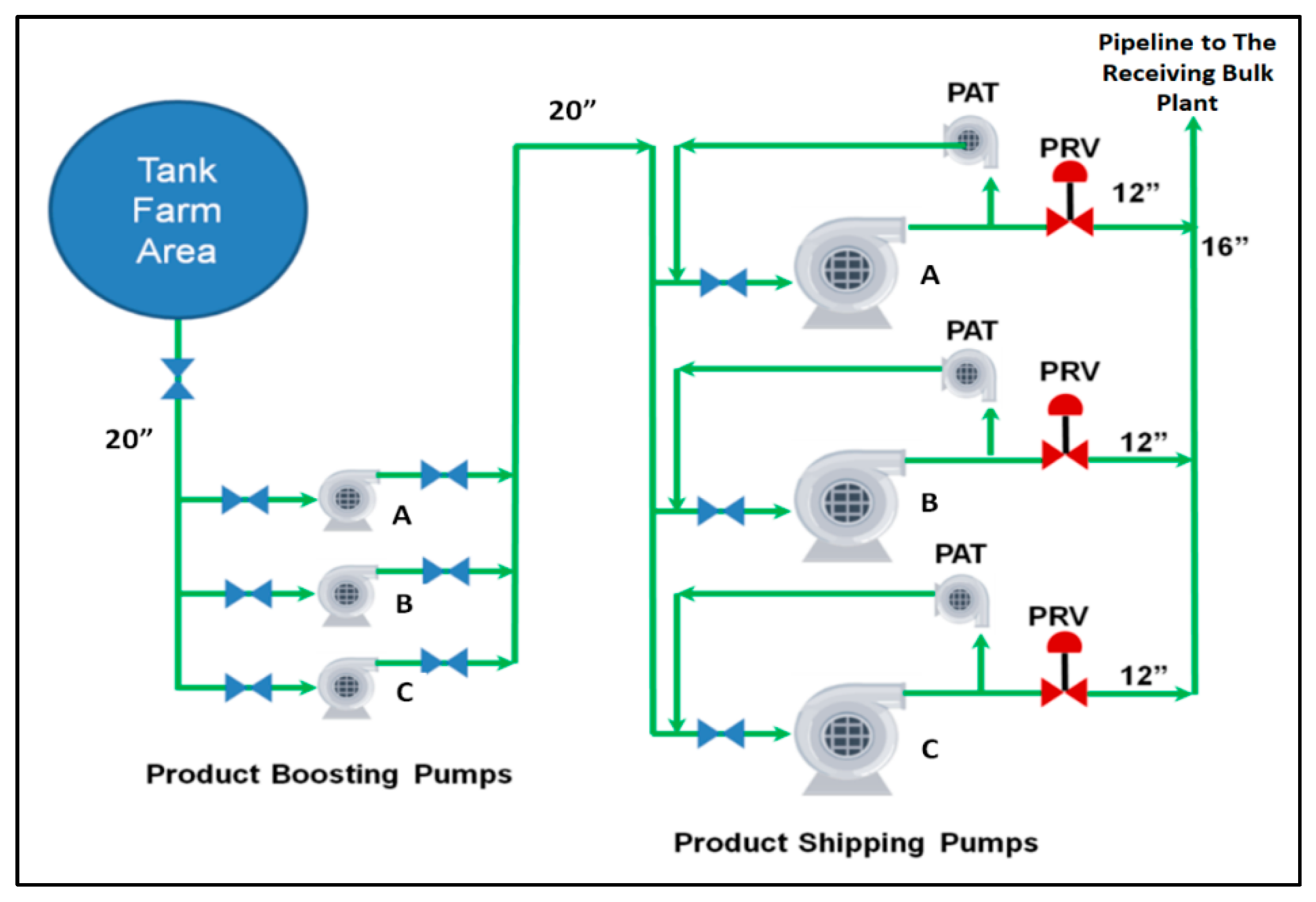

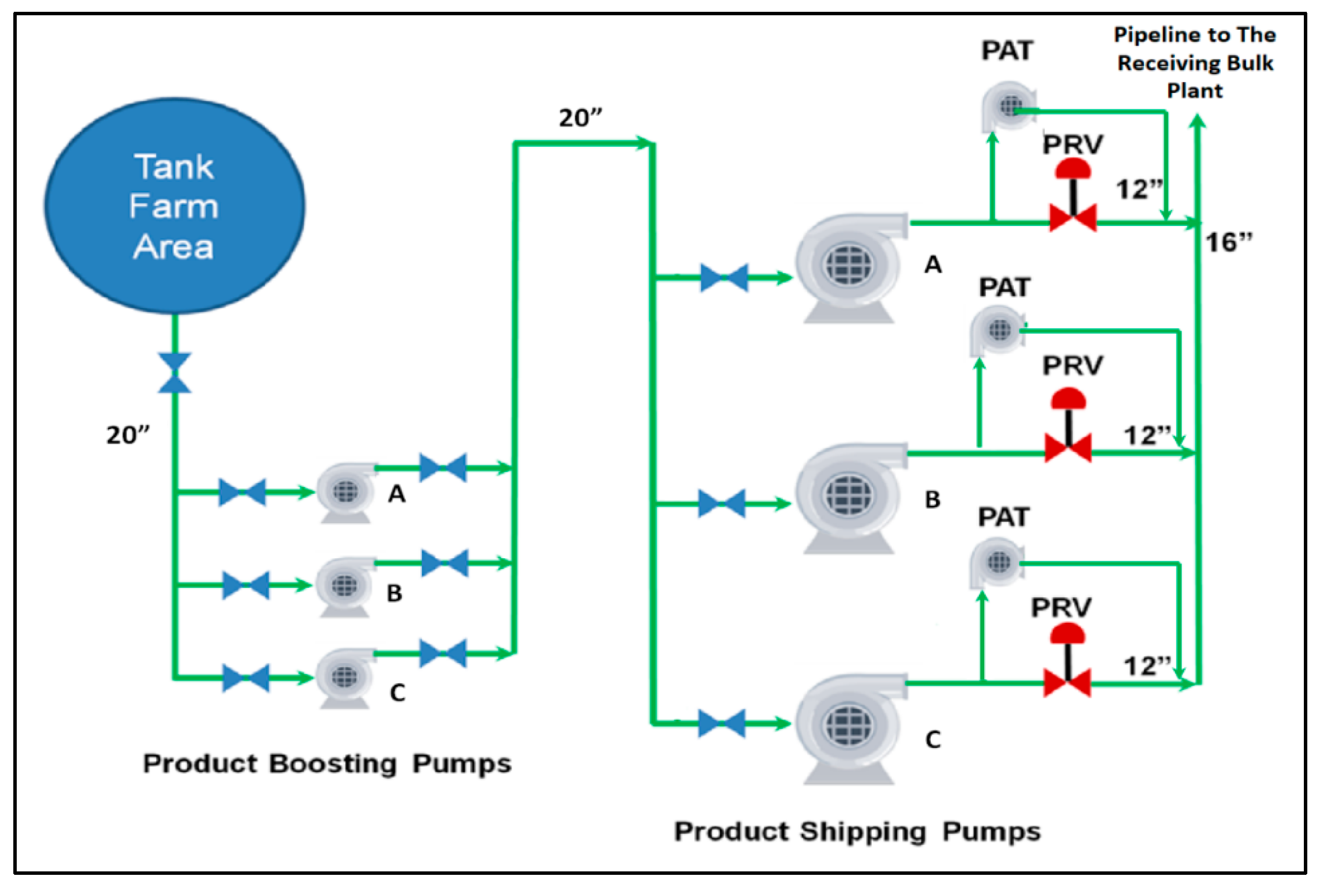
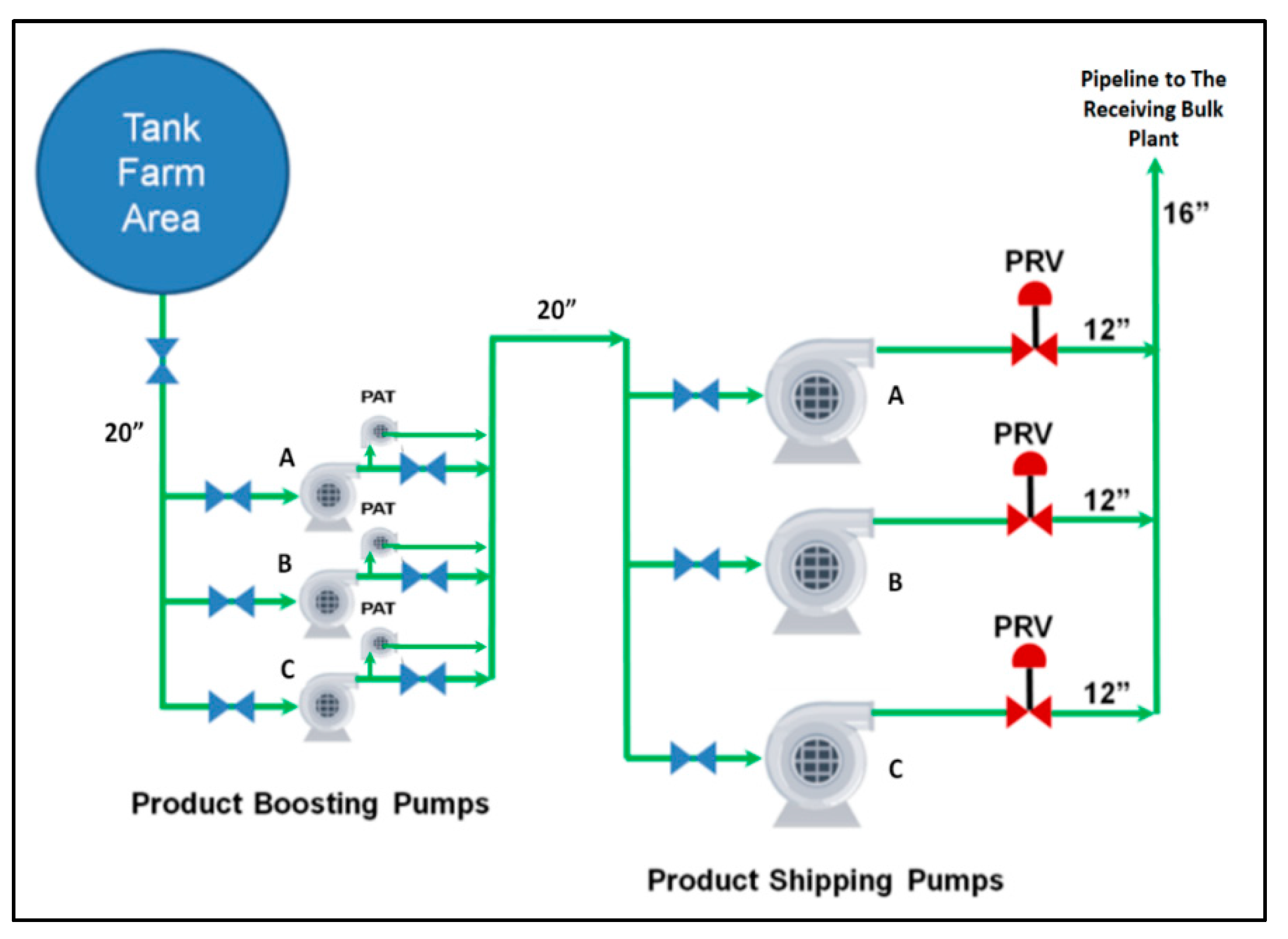
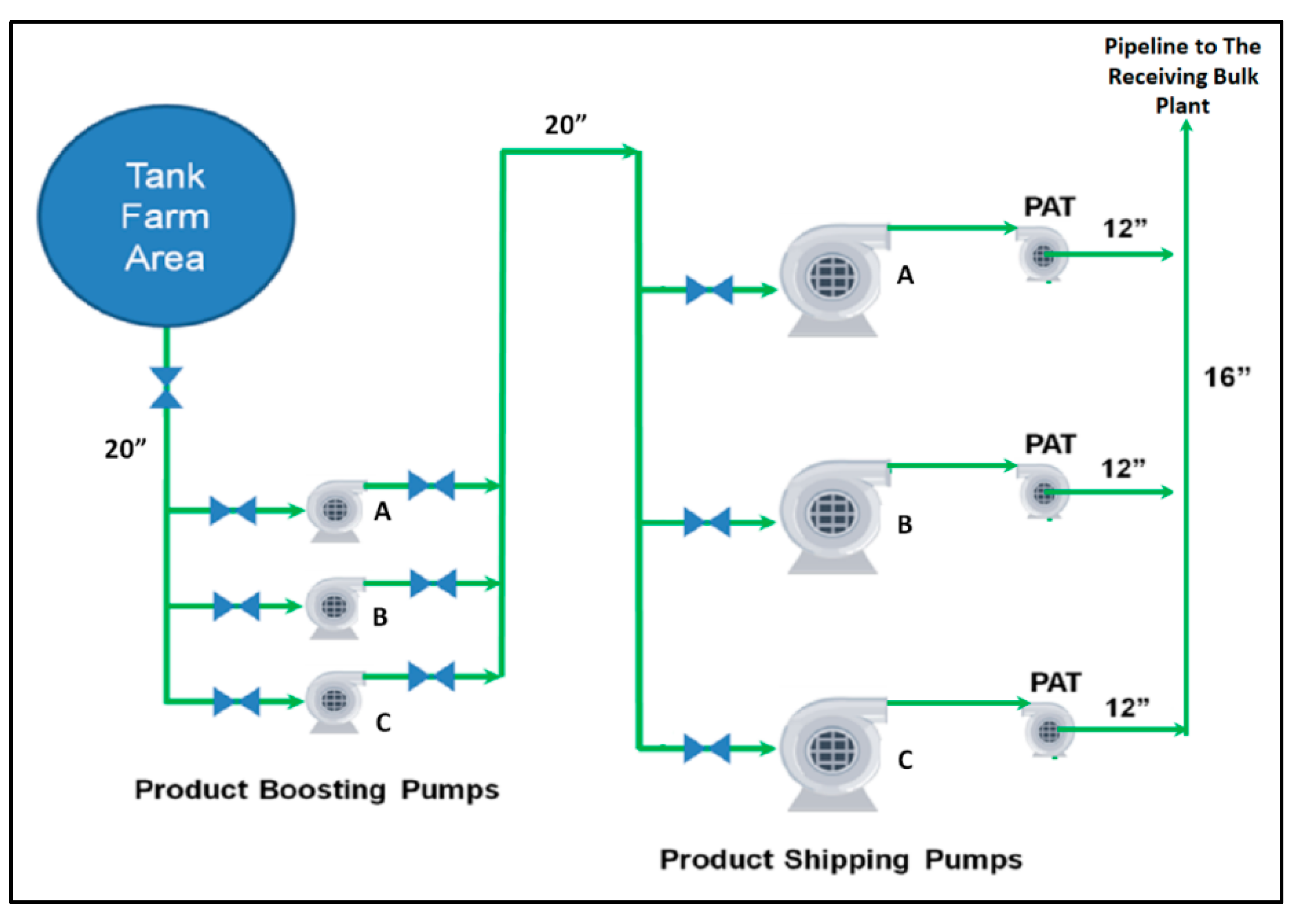
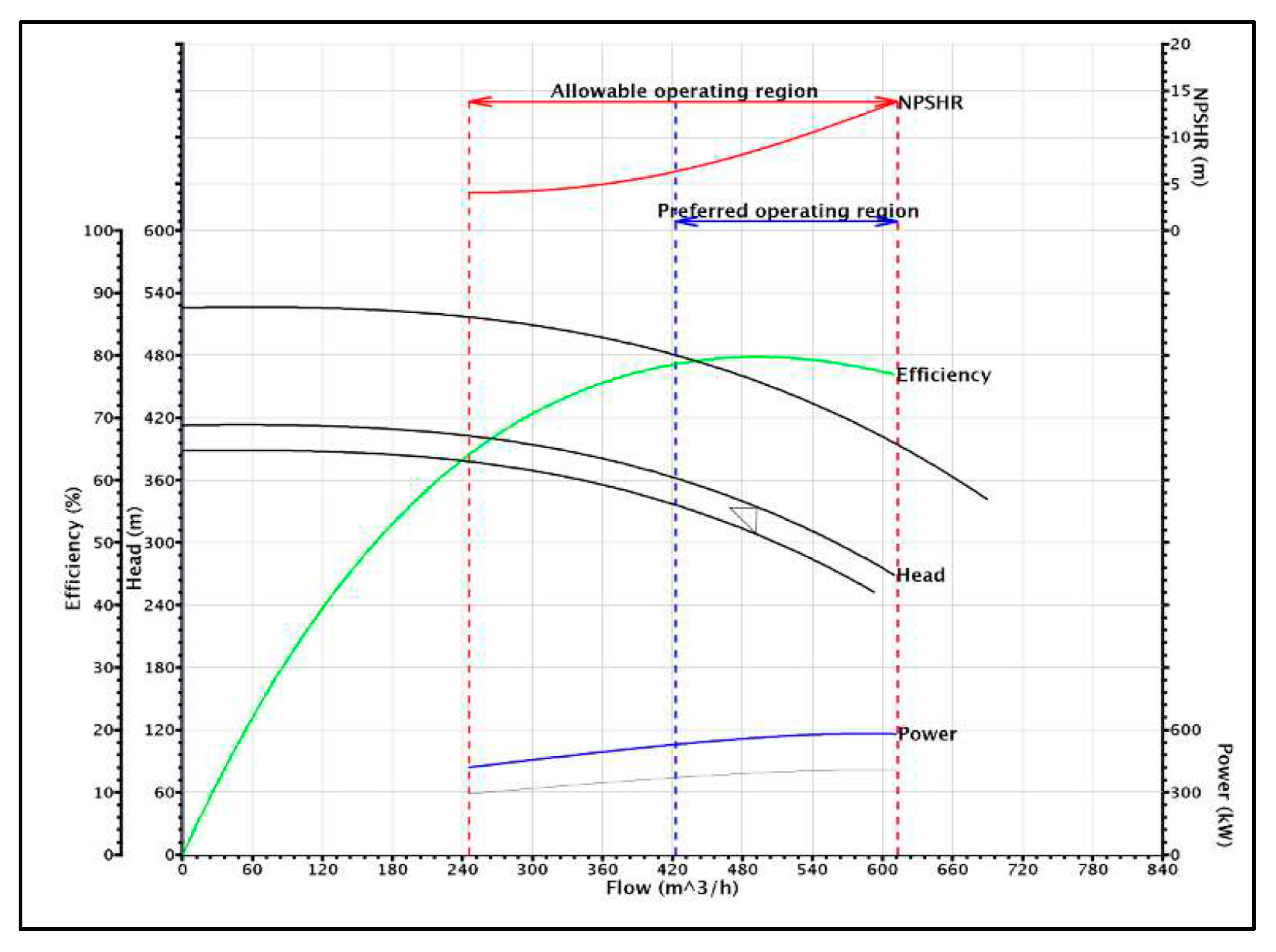

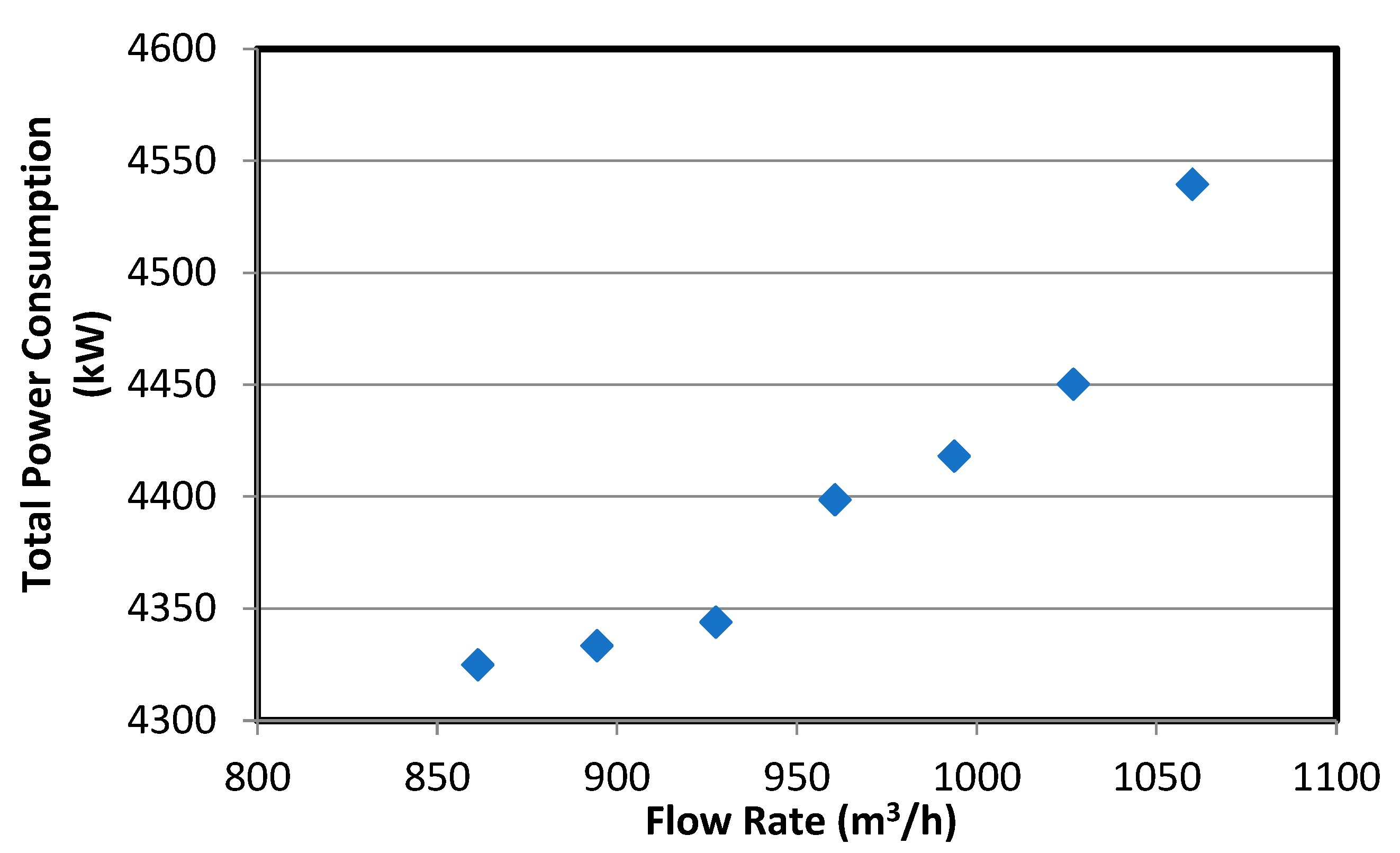
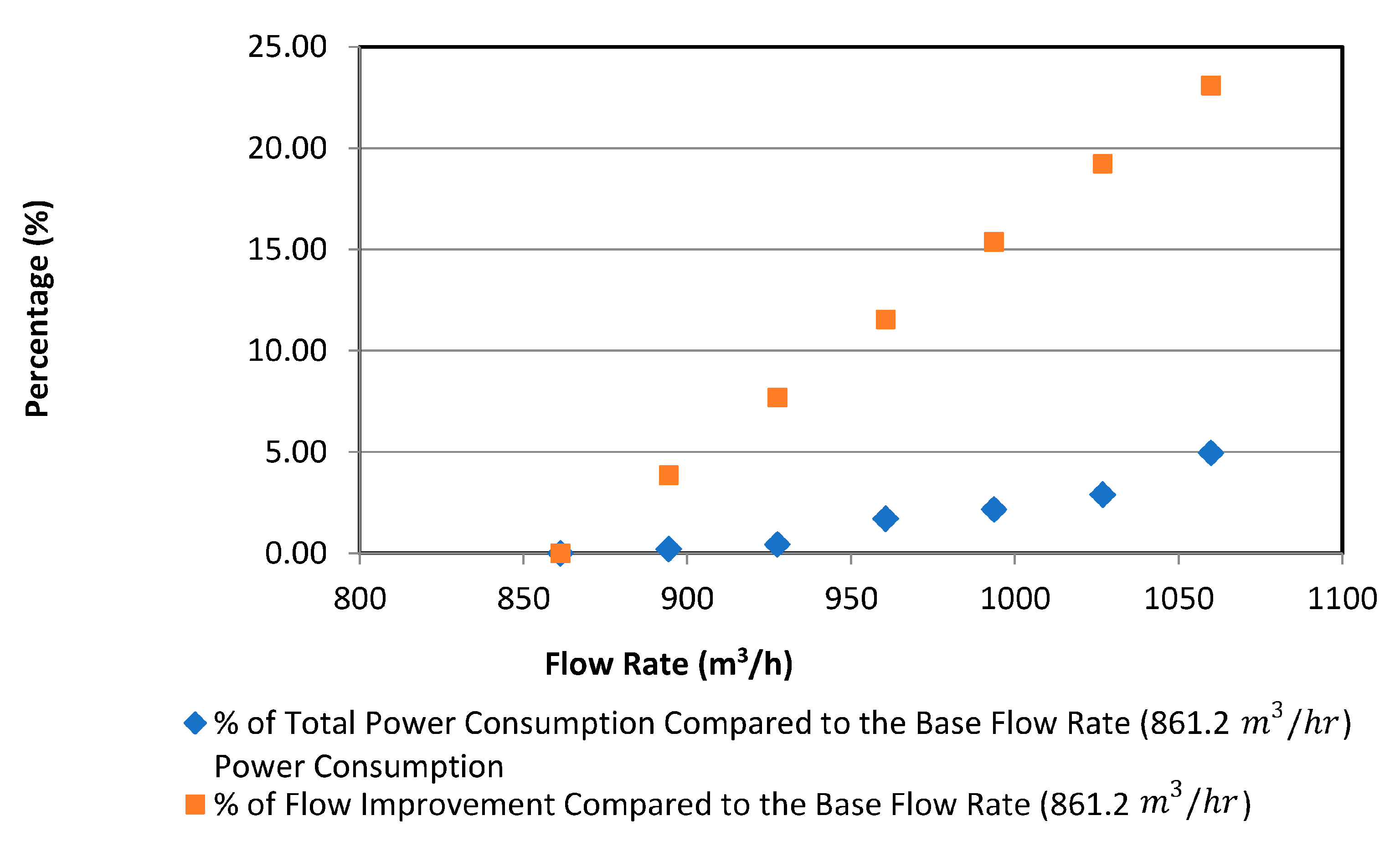
| Pump Information | Booster-Pumps A/B/C | Shipper-Pump A | Shipper-Pumps B/C |
|---|---|---|---|
| Rated Flow (m3/h) | 736 | 736 | 563 |
| Discharge Head (m) | 75 | 1320 | 1297 |
| Flow at BEP (m3/h) | 550 | 736 | 643 |
| Discharge Head at BEP (m) | 91 | 1320 | 1206 |
| Rotational Speed (RPM) | 1788 | 3580 | 3580 |
| Efficiency (%) | 79 | 82 | 81 |
| Operating Mode | Pumps Used | Flow Rate (m3/h) |
|---|---|---|
| Single Mode (single shipper and single booster pump) | Booster-Pump B Shipper-Pump B | 662 |
| Semiparallel Mode (single shipper and two booster pumps) | Booster-Pump A and B Shipper-Pump B | 828 |
| Parallel Mode (two shipper and two booster pumps) | Booster-Pump A and B Shipper-Pump B and C | 1060 |
| Manufacturer Data | Pumping Facility Operating Modes | ||
|---|---|---|---|
| Single | Semiparallel | Parallel | |
| Pump Model | 6X11-D MSN | 8X13-D MSN | 6X11-D MSN |
| Number of Stages | 3 | 3 | 4 |
| Impeller Diameter (mm) | 260.4 | 295.7 | 267.9 |
| Inlet nozzle size | 10 | 12 | 10 |
| Outlet nozzle size | 6 | 8 | 6 |
| Rotational Speed (RPM) | 3600 | 3600 | 3600 |
| Pump Efficiency at BEP (%) | 79.7 | 83.0 | 80.6 |
| Pump Flow at BEP (m3/h) | 510 | 715 | 530 |
| Pump Head at BEP (m) | 329 | 410 | 458 |
| Turbine Efficiency at BEP (%) | 80 | 82.9 | 80 |
| Turbine Flow at BEP (m3/h) | 610 | 850 | 630 |
| Turbine Head at BEP (m) | 440 | 520 | 624 |
| Pump Power at BEP and SG = 0.70 (W) | 401,580 | 673,715 | 574,475 |
| Pump Power at BEP and SG = 0.85 (W) | 487,633 | 818,083 | 697,576 |
| Turbine Power at BEP and SG = 0.70 (W) | 409,578 | 698,942 | 599,901 |
| Turbine Power at BEP and SG = 0.85 (W) | 497,345 | 848,716 | 728,451 |
| Turbine Power at design and SG = 0.70 (W) | 485,300 | 649,300 | 369,200 |
| Turbine Power at design and SG = 0.85 (W) | 588,100 | 787,500 | 446,900 |
| Mode of Operation | Head vs. Flow Rate |
|---|---|
| Single Mode | |
| Semiparallel Mode | |
| Parallel Mode |
| Mode of Operation | Head vs. Flow Rate |
|---|---|
| Single Mode | |
| Semiparallel Mode | |
| Parallel Mode |
| Mode of Operation | PAT Power vs. Flow Rate |
|---|---|
| Single Mode | |
| Semiparallel Mode | |
| Parallel Mode |
| Mode of Operation | PAT Selected Model | EGE Cost (USD) |
|---|---|---|
| Single Mode | 6X11-D MSN | 350,000–500,000 |
| Semiparallel Mode | 8X13-D MSN | 350,000–500,000 |
| Parallel Mode | 6X11-D MSN | 350,000–500,000 |
| Flow Rate (m3/h) | Operating Mode | Power Consumption (kW) | Pumping Cost (USD) | Pumping Cost (USD/m3) |
|---|---|---|---|---|
| 662 | Single Mode | 2434 | 1,705,912 | 0.29 |
| 828 | Semiparallel Model | 3405 | 2,386,120 | 0.33 |
| 1060 | Parallel Mode | 4540 | 3,181,267 | 0.34 |
| Operating Mode | Available Flow Rate (m3/h) | Available Average Head (m) |
|---|---|---|
| Single Mode (single shipper and single booster pump) | 662 | 500 |
| Semiparallel Mode (single shipper and two booster pumps) | 828 | 500 |
| Parallel Mode (two shipper and two booster pumps) | 1060 (530 across each PRV) | 500 (across each PRV) |
| Operating Mode | Theoretical Available Power Diesel Pumping (kw) | Theoretical Available Power Gasoline Pumping (kW) |
|---|---|---|
| Single Mode (single shipper and single booster pump) | 767 | 632 |
| Semiparallel Mode (single shipper and two booster pumps) | 959 | 790 |
| Parallel Mode (two shipper and two booster pumps) | 1228 for both PRVs | 1011 for both PRVs |
| Operating Mode | Percentage of Power Recovered during Diesel Pumping (%) | Percentage of Power Recovered during Gasoline Pumping (%) |
|---|---|---|
| Single Mode | 76.7 | 76.8 |
| Semiparallel Mode | 82.1 | 82.2 |
| Parallel Mode | 72.8 | 73.0 |
| Model | Flow Ratio (q) | Deviation % | Head Ratio (h) | Deviation % |
|---|---|---|---|---|
| Nautiyal et al. [18] | 0.98 | −19.59 | 1.02 | −21.59 |
| Stepanoff [19] | 1.14 | −6.60 | 1.31 | 0.53 |
| Childs [20] | 1.31 | 6.78 | 1.31 | 0.53 |
| Sharma [21] | 1.24 | 1.21 | 1.38 | 6.07 |
| Alatorre and Thomas [22] | 1.68 | 37.15 | 1.65 | 26.56 |
| Yang et al. [13] | 1.39 | 13.59 | 1.61 | 23.92 |
| Derakhshan and Nourbakhsh [6] | 1.52 | 24.58 | 1.74 | 33.76 |
| Proposed Model | 1.23 | 0.45 | 1.39 | 4.32 |
| Experimental Results [8] | 1.22 | 0 | 1.30 | 0 |
| Model | Flow Ratio (q) | Deviation % | Head Ratio (h) | Deviation % |
|---|---|---|---|---|
| Nautiyal et al. [18] | 1.37 | −6.31 | 1.56 | −16.25 |
| Stepanoff [19] | 1.13 | −23.18 | 1.27 | −31.62 |
| Childs [20] | 1.27 | −13.41 | 1.27 | −31.62 |
| Sharma [21] | 1.21 | −17.46 | 1.33 | −28.27 |
| Alatorre and Thomas [22] | 1.56 | 6.52 | 1.56 | −16.13 |
| Yang et al. [13] | 1.37 | −6.71 | 1.56 | −15.96 |
| Derakhshan and Nourbakhsh [6] | 1.39 | −5.08 | 1.54 | −16.98 |
| Proposed Model | 1.37 | −6.43 | 1.18 | −16.89 |
| Experimental Results [8] | 1.47 | 0 | 1.86 | 0 |
| Model | Flow Ratio (q) | Deviation % | Head Ratio (h) | Deviation % |
|---|---|---|---|---|
| Sharma [21] | 1.45 | −12.7 | 1.74 | −7.9 |
| Stepanoff [19] | 1.26 | −24.1 | 1.58 | −16.4 |
| Proposed Model | 1.75 | 5.42 | 1.44 | −5.2 |
| Experimental Results [13] | 1.66 | 0 | 1.89 | 0 |
| Mode of Operation | EGE (USD) | CW (USD) | ACS (USD) | MC (USD) | CPP (Years) |
|---|---|---|---|---|---|
| Single Mode | 425,000 | 127,500 | 340,098.24 | 55,250 | 1.94 |
| Semiparallel Mode | 425,000 | 127,500 | 455,029.44 | 55,250 | 1.38 |
| Parallel Mode | 425,000 | 127,500 | 258,735.36 | 55,250 | 2.72 |
| Mode of Operation | EGE (USD) | CW (USD) | ACS (USD) | MC (USD) | CPP (Years) |
|---|---|---|---|---|---|
| Single Mode | 425,000 | 127,500 | 412,140.48 | 55,250 | 1.55 |
| Semiparallel Mode | 425,000 | 127,500 | 551,880 | 55,250 | 1.11 |
| Parallel Mode | 425,000 | 127,500 | 313,187.52 | 55,250 | 2.14 |
| Mode of Operation | EGE (USD) | CW (USD) | ACS (USD) | MC (USD) | CPP (Years) |
|---|---|---|---|---|---|
| Single Mode | 425,000 | 127,500 | 394,129.92 | 55,250 | 1.63 |
| Semiparallel Mode | 425,000 | 127,500 | 527,667.36 | 55,250 | 1.17 |
| Parallel Mode | 850,000 | 255,000 | 599,148.96 | 110,500 | 2.26 |
Disclaimer/Publisher’s Note: The statements, opinions and data contained in all publications are solely those of the individual author(s) and contributor(s) and not of MDPI and/or the editor(s). MDPI and/or the editor(s) disclaim responsibility for any injury to people or property resulting from any ideas, methods, instructions or products referred to in the content. |
© 2023 by the authors. Licensee MDPI, Basel, Switzerland. This article is an open access article distributed under the terms and conditions of the Creative Commons Attribution (CC BY) license (https://creativecommons.org/licenses/by/4.0/).
Share and Cite
Al-Suhaibani, Z.; Danish, S.N.; Al-Khalaf, Z.S.; Salim, B. Improved Prediction Model and Utilization of Pump as Turbine for Excess Power Saving from Large Pumping System in Saudi Arabia. Sustainability 2023, 15, 1014. https://doi.org/10.3390/su15021014
Al-Suhaibani Z, Danish SN, Al-Khalaf ZS, Salim B. Improved Prediction Model and Utilization of Pump as Turbine for Excess Power Saving from Large Pumping System in Saudi Arabia. Sustainability. 2023; 15(2):1014. https://doi.org/10.3390/su15021014
Chicago/Turabian StyleAl-Suhaibani, Zeyad, Syed Noman Danish, Ziyad Saleh Al-Khalaf, and Basharat Salim. 2023. "Improved Prediction Model and Utilization of Pump as Turbine for Excess Power Saving from Large Pumping System in Saudi Arabia" Sustainability 15, no. 2: 1014. https://doi.org/10.3390/su15021014
APA StyleAl-Suhaibani, Z., Danish, S. N., Al-Khalaf, Z. S., & Salim, B. (2023). Improved Prediction Model and Utilization of Pump as Turbine for Excess Power Saving from Large Pumping System in Saudi Arabia. Sustainability, 15(2), 1014. https://doi.org/10.3390/su15021014









